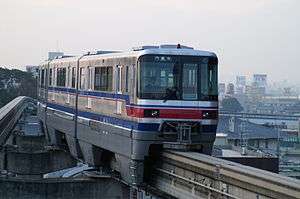Osaka Monorail
The Osaka Monorail (大阪モノレール, Ōsaka Monorēru) is a monorail in northern Osaka Prefecture, Japan, operated by Osaka Monorail Co., Ltd. (大阪モノレール株式会社, Ōsaka Monorēru kabushiki gaisha). At 28 kilometres (17 mi) long, it is the second longest monorail system in the world after the Chongqing Monorail. It links the three campuses of Osaka University.
Osaka Monorail route map | |||||||||||||||||||||||||||||||||||||||||||||||||||||||||||||||||||||||||||||||||||||||||||||||||||||||||||||||||||||||||||||||||||||||||||||||||||||||||||||||||||||||||||||||||||||||||||||||||||||||||||||||||||||||||||||||||||||||||||||||||||||||||||||||||||||||||||||||||||||||||||||||||||||||||||||||||||||||||||||||||||||||||||||||||||||||
|---|---|---|---|---|---|---|---|---|---|---|---|---|---|---|---|---|---|---|---|---|---|---|---|---|---|---|---|---|---|---|---|---|---|---|---|---|---|---|---|---|---|---|---|---|---|---|---|---|---|---|---|---|---|---|---|---|---|---|---|---|---|---|---|---|---|---|---|---|---|---|---|---|---|---|---|---|---|---|---|---|---|---|---|---|---|---|---|---|---|---|---|---|---|---|---|---|---|---|---|---|---|---|---|---|---|---|---|---|---|---|---|---|---|---|---|---|---|---|---|---|---|---|---|---|---|---|---|---|---|---|---|---|---|---|---|---|---|---|---|---|---|---|---|---|---|---|---|---|---|---|---|---|---|---|---|---|---|---|---|---|---|---|---|---|---|---|---|---|---|---|---|---|---|---|---|---|---|---|---|---|---|---|---|---|---|---|---|---|---|---|---|---|---|---|---|---|---|---|---|---|---|---|---|---|---|---|---|---|---|---|---|---|---|---|---|---|---|---|---|---|---|---|---|---|---|---|---|---|---|---|---|---|---|---|---|---|---|---|---|---|---|---|---|---|---|---|---|---|---|---|---|---|---|---|---|---|---|---|---|---|---|---|---|---|---|---|---|---|---|---|---|---|---|---|---|---|---|---|---|---|---|---|---|---|---|---|---|---|---|---|---|---|---|---|---|---|---|---|---|---|---|---|---|---|---|---|---|---|---|---|---|---|---|---|---|---|---|---|---|---|---|---|---|---|---|---|---|---|---|---|---|---|---|---|---|---|---|---|---|---|---|---|---|
| |||||||||||||||||||||||||||||||||||||||||||||||||||||||||||||||||||||||||||||||||||||||||||||||||||||||||||||||||||||||||||||||||||||||||||||||||||||||||||||||||||||||||||||||||||||||||||||||||||||||||||||||||||||||||||||||||||||||||||||||||||||||||||||||||||||||||||||||||||||||||||||||||||||||||||||||||||||||||||||||||||||||||||||||||||||||
 | |
 | |
| Overview | |
|---|---|
| Locale | Osaka Prefecture |
| Transit type | straddle-beam Monorail |
| Number of lines | 2 |
| Number of stations | 18 |
| Daily ridership | 131,479 daily boardings (2017)[1] |
| Operation | |
| Began operation | 1990 |
| Operator(s) | Osaka Monorail Co., Ltd. |
| Technical | |
| System length | 28.0 km (17.4 mi) |
| Minimum radius of curvature | 100 m (330 ft) |
| Electrification | 1,500 V DC |
| Top speed | 75 km/h (47 mph) |
 | |
Native name | 大阪モノレール株式会社 |
|---|---|
Romanized name | Ōsaka Monorēru kabushiki gaisha |
| Private KK | |
| Founded | Toyonaka, Osaka, Japan (December 15, 1980) |
| Headquarters | 1-5, Shin-Senri-higashimachi Itchome, Toyonaka, Osaka, Japan |
Area served | northern Osaka Prefecture |
| Owner | Osaka Prefectural Government (65.1%) Keihan Holdings Co. (2.7%) Hankyu Corporation (2.7%) Kintetsu Group Holdings Co. (2.7%) 7 municipalities and 17 companies, including Toyonaka municipal government (total 26.8%) |
| Website | www.osaka-monorail.co.jp/ |
Main Line
The Main Line runs on an elevated line between Osaka International Airport and Kadoma. It opened on June 1, 1990 between Senri-Chuo and Minami-Ibaraki stations. On September 30, 1994 it reached Shibahara Station, on April 1, 1997, Osaka Airport, and on August 22, 1997, its current eastern terminal at Kadoma-shi Station. It is 21.2 km long. A single-way trip over the entire Main Line takes about 36 minutes, and costs ¥550.
Station list
| Status | Station number | Station | Japanese | Distance (km) | Transfers | Location | |
|---|---|---|---|---|---|---|---|
| In operation | 11 | Osaka Airport Station | 大阪空港駅 | 0.0 | Toyonaka | Osaka Prefecture | |
| 12 | Hotarugaike Station | 蛍池駅 | 1.4 | Hankyu Railway Takarazuka Line | |||
| 13 | Shibahara Station | 柴原駅 | 3.1 | ||||
| 14 | Shōji Station | 少路駅 | 4.8 | ||||
| 15 | Senri-Chūō Station | 千里中央駅 | 6.6 | Kita-Osaka Kyuko Railway | |||
| 16 | Yamada Station | 山田駅 | 8.5 | Hankyu Railway Senri Line | Suita | ||
| 17 | Banpaku-Kinen-Koen Station | 万博記念公園駅 | 9.9 | Osaka Monorail Saito Line | |||
| 18 | Unobe Station | 宇野辺駅 | 12.1 | Ibaraki | |||
| 19 | Minami Ibaraki Station | 南茨木駅 | 13.3 | Hankyu Railway Kyoto Line | |||
| 20 | Sawaragi Station | 沢良宜駅 | 14.5 | ||||
| 21 | Settsu Station | 摂津駅 | 16.0 | Settsu | |||
| 22 | Minami Settsu Station | 南摂津駅 | 17.8 | ||||
| 23 | Dainichi Station | 大日駅 | 19.9 | Osaka Metro Tanimachi Line | Moriguchi | ||
| 24 | Kadoma-shi Station | 門真市駅 | 21.2 | Keihan Electric Railway Keihan Main Line | Kadoma | ||
| Planned | 25 | Kadoma-minami Station[Note 1] | 門真南駅(仮称) | Osaka Metro Nagahori Tsurumi-ryokuchi Line | |||
| 26 | Kōnoikeshinden Station[Note 1] | 鴻池新田駅(仮称) | JR West Katamachi Line | Higashiosaka | |||
| 27 | Aramoto Station[Note 1] | 荒本駅(仮称) | Kintetsu Keihanna Line | ||||
| 28 | Uryūdō Station[Note 1] | 瓜生堂駅(仮称) | Kintetsu Nara Line | ||||
- Notes
- Tentative name.
Saito Line
The Saito Line branch opened in two stages: on October 1, 1998 from Bampaku-kinen-koen Station to Handai-byoin-mae Station, and on March 19, 2007, to Saito-nishi Station, in the residential area of Saito, about a kilometer from the Minoo Campus of Osaka University (former Osaka University of Foreign Studies). The branch is 6.8 km long.
Station list
| Station No. | Station | Japanese | Distance (km) | Transfers | Location | |
|---|---|---|---|---|---|---|
| 17 | Banpaku-Kinen-Kōen | 万博記念公園 | 0.0 | Osaka Monorail Main Line | Suita | Osaka Prefecture |
| 51 | Kōen-higashiguchi | 公園東口 | 1.1 | |||
| 52 | Handai-byōin-mae | 阪大病院前 | 2.6 | Ibaraki | ||
| 53 | Toyokawa | 豊川 | 4.2 | |||
| 54 | Saito-nishi | 彩都西 | 6.8 | |||
Rolling stock
Current
Extension
In 2015, Osaka Prefecture announced plans to extend the monorail to Uryudo in Higashiōsaka.[2]
See also
- Monorails in Japan
- List of rapid transit systems
References
- "大阪モノレール 企業情報:運輸成績>運輸成績:旅客数及び旅客収入".
- UK, DVV Media. "Osaka Monorail extension planned". Railway Gazette. Retrieved 28 February 2018.